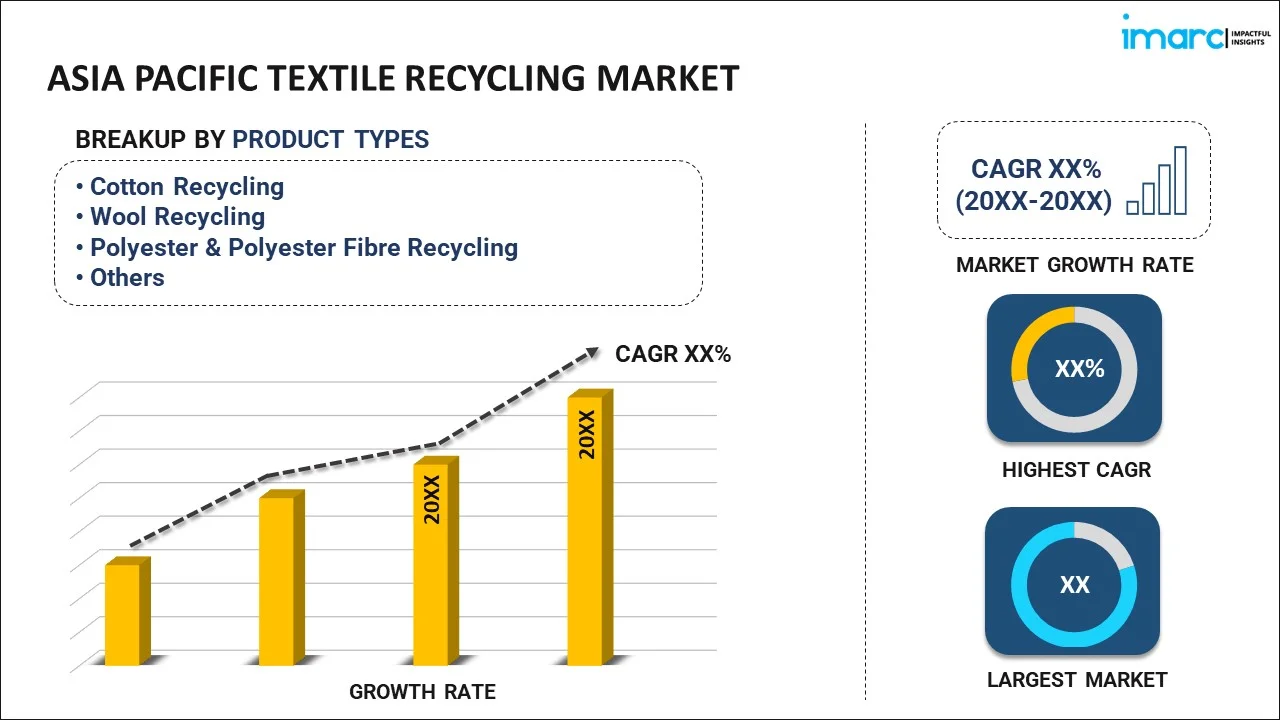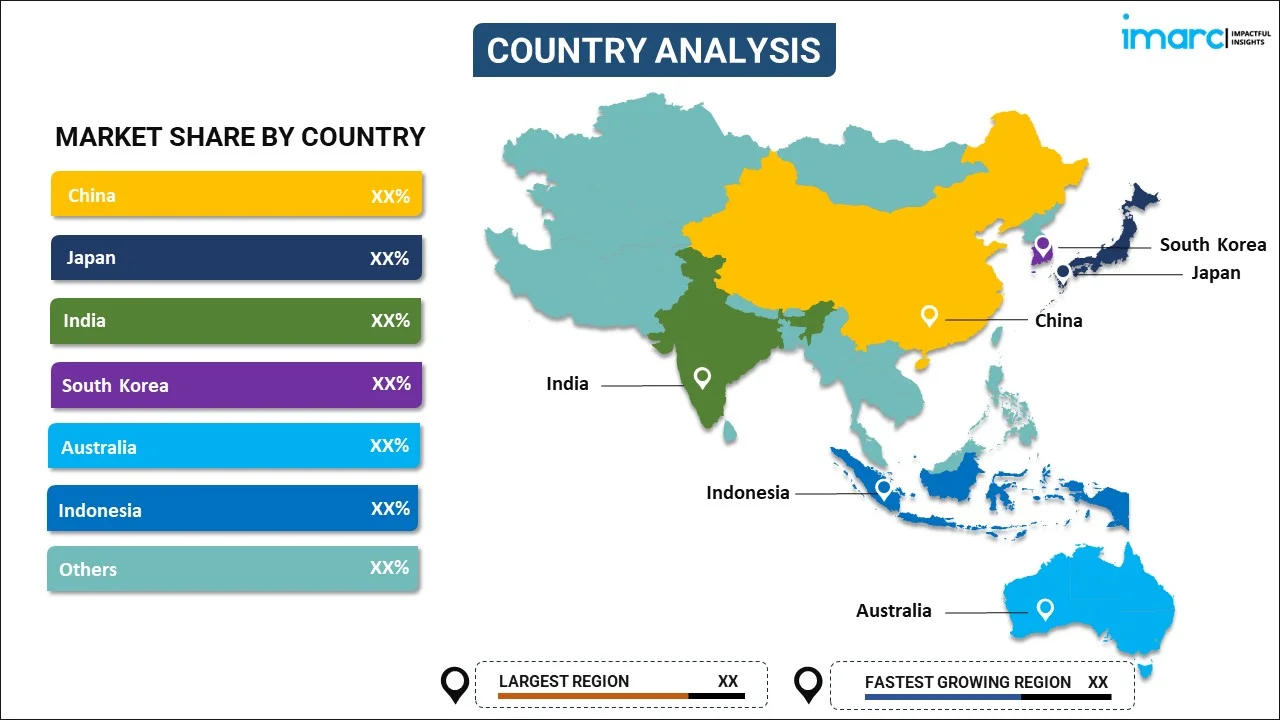
Asia Pacific Textile Recycling Market Report by Product Type (Cotton Recycling, Wool Recycling, Polyester & Polyester Fibre Recycling, Nylon & Nylon Fibre Recycling, and Others), Textile Waste (Pre-consumer Textile, Post-consumer Textile), Distribution Channel (Online Channel, Retail & Departmental Stores), End Use (Apparel, Industrial, Home Furnishings, Non-woven, and Others), and Country 2025-2033
Market Overview 2025-2033:
The Asia Pacific textile recycling market size reached USD 1.82 Billion in 2024. Looking forward, IMARC Group expects the market to reach USD 2.28 Billion by 2033, exhibiting a growth rate (CAGR) of 2.44% during 2025-2033.
|
Report Attribute
|
Key Statistics
|
|---|---|
|
Base Year
|
2024
|
|
Forecast Years
|
2025-2033
|
|
Historical Years
|
2019-2024
|
|
Market Size in 2024
|
USD 1.82 Billion |
|
Market Forecast in 2033
|
USD 2.28 Billion |
| Market Growth Rate (2025-2033) | 2.44% |
Textile recycling assists in reusing and reprocessing old clothes, scraps, and fibrous waste materials. It helps reduce land and water pollution, minimize dependence on virgin fibers, and optimize the consumption of energy and water. As a result, it finds extensive application in apparel, automotive, construction, mining, and retail sectors across the Asia Pacific region.
The rising demand for recycled textiles on account of the increasing environmental concerns among individuals represents one of the primary factors propelling the growth of the market in the Asia Pacific region. Besides this, on account of their comfort and associated benefits, there is a significant shift towards home textiles. This is offering lucrative opportunities to leading players operating in the industry.
Key Market Segmentation:
IMARC Group provides an analysis of the key trends in each sub-segment of the Asia Pacific textile recycling market report, along with forecasts at the regional and country level from 2025-2033. Our report has categorized the market based on product type, textile waste, distribution channel, and end use.
Breakup by Product Type:

- Cotton Recycling
- Wool Recycling
- Polyester & Polyester Fibre Recycling
- Nylon & Nylon Fibre Recycling
- Others
Breakup by Textile Waste:
- Pre-consumer Textile
- Post-consumer Textile
Breakup by Distribution Channel:
- Online Channel
- Retail & Departmental Stores
Breakup by End Use:
- Apparel
- Industrial
- Home Furnishings
- Non-woven
- Others
Breakup by Country:

- China
- Japan
- India
- South Korea
- Australia
- Indonesia
- Others
Competitive Landscape:
The competitive landscape of the industry has also been examined along with the profiles of the key players.
Report Coverage:
| Report Features | Details |
|---|---|
| Base Year of the Analysis | 2024 |
| Historical Period | 2019-2024 |
| Forecast Period | 2025-2033 |
| Units | Billion USD |
| Segment Coverage | Product Type, Textile Waste, Distribution Channel, End Use, Country |
| Countries Covered | China, Japan, India, South Korea, Australia, Indonesia, Others |
| Customization Scope | 10% Free Customization |
| Post-Sale Analyst Support | 10-12 Weeks |
| Delivery Format | PDF and Excel through Email (We can also provide the editable version of the report in PPT/Word format on special request) |
Key Questions Answered in This Report
The Asia Pacific textile recycling market was valued at USD 1.82 Billion in 2024.
We expect the Asia Pacific textile recycling market to exhibit a CAGR of 2.44% during 2025-2033.
The rising adoption of textile recycling as it offers various economic and environmental benefits, including preventing the use of chemical dyes, reducing water and land pollution levels, minimizing dependence on virgin fibers, etc., is primarily driving the Asia Pacific textile recycling market.
The sudden outbreak of the COVID-19 pandemic had led to the implementation of stringent lockdown regulations across several Asia Pacific nations, resulting in the temporary halt in numerous production activities for textile recycling.
Based on the product type, the Asia Pacific textile recycling market has been divided into cotton recycling, wool recycling, polyester & polyester fiber recycling, nylon & nylon fiber recycling, and others. Currently, polyester & polyester fiber recycling exhibits a clear dominance in the market.
Based on the textile waste, the Asia Pacific textile recycling market can be categorized into pre-consumer textile and post-consumer textile, where pre-consumer textile holds the majority of the total market share.
Based on the distribution channel, the Asia Pacific textile recycling market has been segmented into online channel and retail & departmental stores. Currently, retail & departmental stores exhibit a clear dominance in the market.
Based on the end use, the Asia Pacific textile recycling market can be bifurcated into apparel, industrial, home furnishings, non-woven, and others. Among these, apparel accounts for the largest market share.
On a regional level, the market has been classified into China, Japan, India, South Korea, Australia, Indonesia, and others, where China currently dominates the Asia Pacific textile recycling market.
Need more help?
- Speak to our experienced analysts for insights on the current market scenarios.
- Include additional segments and countries to customize the report as per your requirement.
- Gain an unparalleled competitive advantage in your domain by understanding how to utilize the report and positively impacting your operations and revenue.
- For further assistance, please connect with our analysts.
 Inquire Before Buying
Inquire Before Buying
 Speak to an Analyst
Speak to an Analyst
 Request Brochure
Request Brochure
 Request Customization
Request Customization




.webp)




.webp)












